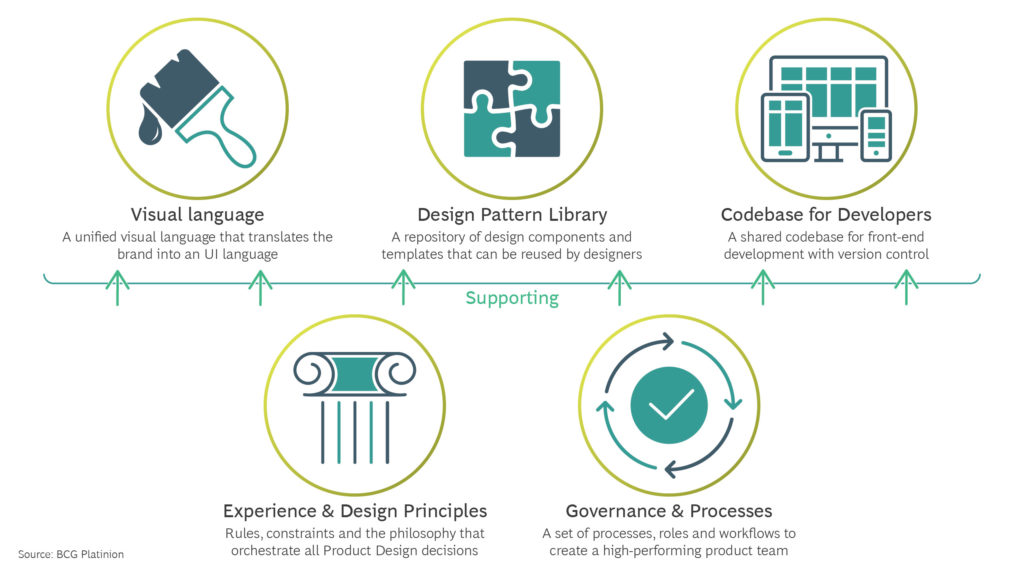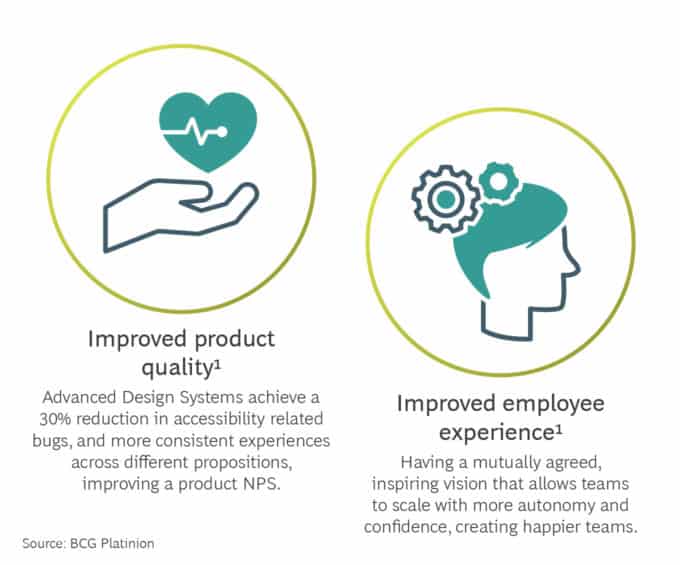As large organisations grow under traditional conditions, structural issues can emerge that limit their ability to deliver high quality products and services in an efficient way. From the increasingly complex demands of an expanding workforce, to evolving customer needs and operational structures, growth comes with significant change that must be managed at scale.
Preparations to mitigate these challenges need to be made at the design level, requiring standards, processes, roles, and workflows to be defined that drive impact and cultivate creativity. At BCG Platinion, we believe Design Systems are the solution to this widespread problem, and in this article, we will explore what they are and their many benefits.
Understanding Design Systems
Design Systems are living, self-funded solutions that support an ecosystem of products and services, with their benefits generating significantly more revenue than they cost to fund. They are put in place to drive impact and maximise value at the operational level, prioritising efficiency, quality, and talent as critical enablers. Crucially, Design Systems streamline operations and minimise complexity, providing the guardrails for an organisation to pursue its goals with creativity and ambition at scale.
At a foundational level, Design Systems introduce experience and design principles, as well as governance and processes. The principles are a set of rules and a philosophy that will ultimately orchestrate an organisation’s ongoing product design decisions. Governance and processes involve the defining of roles and workflows that will facilitate a high-performing product team.

With the right principles and processes in place, Design Systems support a selection of capabilities that optimise an organisation’s operations as it grows. The first is a unified visual language that translates the company brand into a consistent user interface, which plays a vital role in upholding a high level of efficiency and service quality as the organisation evolves.
The use of Design Systems includes the implementation of a design pattern library, which serves as a central repository for important design components and templates. This capability contributes to a greater degree of consistency and streamlining at scale by allowing designers to efficiently reuse resources. Developers also benefit from the application of Design Systems because of the streamlining they instigate, due to the use of a shared codebase for front-end development with version control.
The Value of Design Systems

On the one hand, Design Systems enable you to speed up your go-to-market approach by an astonishing 50 to 90% , with tested components equipping teams to place more focus on speed and innovation.
This can also be achieved while improving product quality when using advanced Design Systems, with accessibility bugs being reduced by as much as 30% and a more consistent experience overall.
Precision gains can also be expected when implementing Design Systems, with BCG proprietary research finding that they can lead to a 35% reduction in the duplication of efforts.
This significant efficiency increase allows for resources to be pooled and for design and engineering oversight to also be mitigated, resulting in quality products being assembled more easily.
On top of these significant operational advantages, Design Systems have also been found to improve the employee experience as well.
This is because of the greater degree of autonomy and confidence that these systems afford, providing teams with an opportunity to move forward with an inspiring, mutually agreed vision.

1 Forrester – How to Measure the Impact of a Design System, August 2020
2 BCG Proprietary Research

Beginning the Process
The adoption of Design Systems not only transforms your existing operations, but it also lays the groundwork for your organisation’s future growth.
Digitalisation and other factors provide unprecedented opportunities for large organisations in the modern world, but these benefits can be diminished if the growth they achieve is not structured effectively from the start.
Implementing Design Systems enables you to maintain a strong and positive growth trajectory by creating room for innovation, enhancing communication, and building vital consistency at the core of your operations.
Above all, you must identify the most valuable place to begin and mobilise a small team to deliver an alpha, including the pilot journey and operating model. BCG Platinion’s Design experts can help you identify the most valuable place to start.
About the Authors
Ricardo is an award winning design leader with a passion for creating innovative products and services that will have a positive impact in the world. He’s got a great track record of innovation – inspiring the creation of a new department within Google, and designing high-profile digital products across industries, such as Health, Insurance, Consumer, Private Equity and many more.
A Managing Director based in the London office, Phil is a key member of BCG Platinion’s DPS and design team leadership in EMESA. He has extensive experience in innovation, having spent almost 20 years running his own product design and innovation practice which BCG acquired in 2019, which saw him work for many of the world’s leading tech companies including Google, Apple and Microsoft, alongside a wide array of start-up ventures.
Renato is a Design Principal who specializes in Design Systems and Product Design. He has a track record of creating best-in-class products for industry leaders in the Automotive, Tech, Financial, Healthcare and Public Sectors.
Learn more about out work with design:




